You are reading the older HTML site
Positive Feedback ISSUE
43may/june 2009
Audio Ramblings - Empirical Audio Off-Ramp 3, the
von Gaylord
Chinchilla AES/EBU XLR digital cable, Wireworld Supernova™ 5+ Toslink and Ultraviolet™ USB
cables, Locus Design Nucleus USB cable, and the Audioengine W2 and W1
transmitters
by Dave Clark
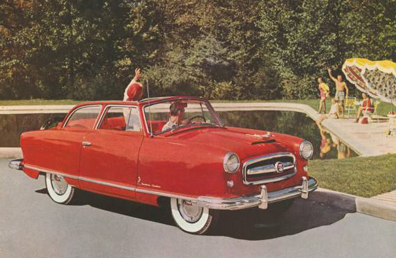
Gee, where to start? Got a lot to close out here… ends to settle and all before I get into the new Empirical Audio Off-Ramp 3 (a 3rd generation USB computer interface that supports sample-rates of up to 24/96 and automatically generates 24/44.1 from 16/44.1 and is as stellar as all get out).
Chinchilla AES/EBU XLR digital cable
How about the Von Gaylord Audio Chinchilla digital interconnect (1.5 meter AES/EBU XLR - $1095)? This is a rather robust and somewhat flexible cable that does what it does and does it quite well. The Chinchilla line of cables are made of multi-gauged twisted and parallel strands of very high purity copper and silver along with braiding to provide RFI and EMI rejection. The Chinchilla (shown below connected to the Cary 306 Professional's XLR digital input) tends to sound 'different' than what I have here in house (Purist Audio Aqueous or DH Labs D-75 XLR digital cables), 'different' in not being worse or better… but just different. Well go figure! Yeah, cables, and digital ones to boot, sound different. Like the PAD being a bit darker, lusher, warmer, and more dimensional, whereas the DH Labs a bit more transparent and detailed (resolving?) which is no doubt reflective of it being more tonally even. Yeah, the DH Labs does dimension and space, has a degree of color, just not to the level of that portrayed by the PAD. Dark the DH Labs is not, but nor is it lean or bright. But then the PAD is not really dark either, just darker than the DH Labs. The DH Labs is quite evenly balanced (neutral-ishly balanced without being negatively neutral-ishly balanced—it ain't analytically clean!) and at its price is a steal ($89 a meter).
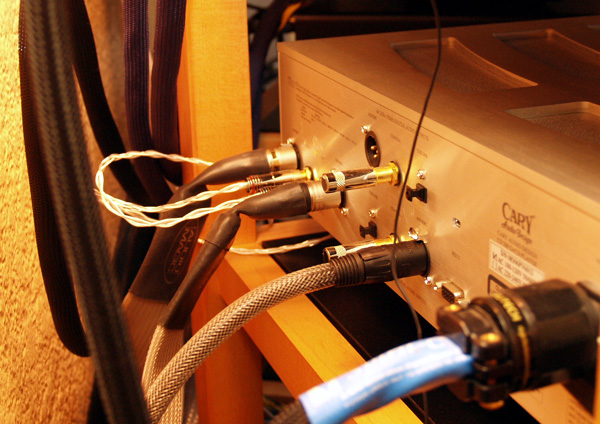
Hey that pretty much sums up the Chinchilla in that it is sort of a mixture of the two. Well not a straight mixture… no, see the Chinchilla has some of the characteristics of both the PAD and the DH Labs without going too far in either direction of their characters. So it is not the best of both worlds (the world of PAD and DH Labs), but it is kind of in the middle of the two cables. This is quite nice.
The Chinchilla has color and presence with a drop-dead quietness all the while offering an extended and airy high (no grain or grit) with a rock-solid deep and palpable bottom-end (like the PAD, just not to the same degree). It also has a nice sense of that neutrality 'rightness' to it… a purity and even-handed way about how it portrays one's bits of music (like the DH Labs to a great degree, but not quite to the same degree).
Okay, so it does have more of a mid-range presence (or balance) than either of the other two digital cables, but this what it brings to the table in terms of its own character. This mid-range character allows for a more delineated mid-range presentation, something that brings the energy of the music to a different level of involvement without sounding lean or bleached of color. Nice. Now I am not saying that the Chinchilla has an upfront of invasively forward midrange, just that is is more apparent in a quite enjoyable way. Yeah, it is rather subtle for sure, but it is clearly evident when compared to either of my reference digital cables. Nice.
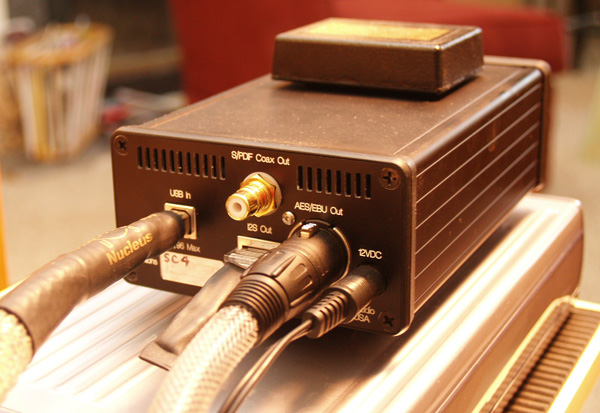
Of course the downside is that the Chinchilla AES/EBU XLR cable (shown above with the Empirical Audio Off-Ramp) is $1095 which puts it in the way higher echelon of cables, so it had better sound like a million bucks at that price and well… it does. A real winner in every way, the Chinchilla offers the music lover a lot for the money.
Von Gaylord Audio www.vongaylordaudio.com
Wireworld Supernova™ 5+ Toslink and Ultraviolet™ USB cables
Okay, how about some other 'digital' cables from Wireworld? In this case their Supernova™ 5+ Toslink ($129.95 a meter) and the Ultraviolet™ USB ($49.95 a meter) cables. The Ultraviolet™ features 26 gauge silver plated oxygen-free copper conductors and a proprietary low-loss ground path to significantly reduce digital jitter and drastically minimizing noise caused by error correction circuits. The Supernova™ features 280 very high quality glass fibers and their custom designed "Gobblegrips" connectors. Both cables are very nicely made and at the price are no-brainers for anyone looking for a quality connector at an affordable price. But if they don't deliver on the sound goods, they ain't worth a sack of frogs. David Salz has outdone himself as these two cables offer the music lover a wealth of detail and musical 'presence' that belies their price. Nice and clean… no grit, glare, noise or other conic nasties are ever presented in the chain that could detract from one's musical nirvana. Both cables are clearly a step up from an entry level USB or optical cable (clearly better than the under $100 assortment I have here) in how they portray the music with a substantial increase in detail and resolution (without adding any etch or brightness that one perceives as detail or resolution). Toss in a natural sense of ease and tonal rightness (a purity of tone perhaps, not absolute, but quite right all the less) along with a lovely liquidity (way so in the Supernova™ Toslink… very nice indeed) and you got a killer product. Plus it is flat... and purple!
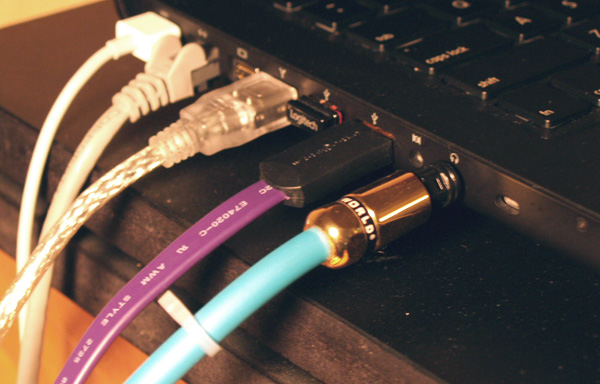
Is it as good as, say, the bigger more costly alternatives? Well, I would say no, not quite, but it is damn nice and quite close. Offerings from say Locus Design (either the Axis at $549 for 3 feet or the Nucleus at $1149 for 3 feet) give you a greater degree of tonal lushness, liquidity, and ultimate resolution (sans any sense of brightness, grit, glare, or whatever crap gets in one's way of musical enjoyment). Yeah, they are simply better. But at x² times the national debt they had better be. Of course one would never know this unless you got the cash for the ride that these two USB cables can offer the listener, so if you don't then don't sweat it - the Ultraviolet™ is way recommended. And it looks cool all purple and flat. Hey it works and I experienced no hiccups, it is not tweaky in the least, and it should last you a life-time (of course in the digital world that is a rather short lifetime, but who's counting)… oh, and musically it is wonderful. And its only $50! I want one!
What about the Supernova™ 5+ compared to say the van den Hul Optocoupler MkII ($110)? Apples to apples? Well, not really. See the Supernova™ 5+ is a glass Toslink and the Optocoupler MkII is a plastic Toslink, plus the Optocoupler MkII has a regular connector at the receiving end and a mini-jack at the sending end… nice considering the Mac Book requires the mini-connector at its output. The Supernova™ 5+ features regular connectors at either end requiring some adaptor to allow its use with the Mac Book… so not really apples to apples. The Optocoupler MkII audibly offers a great sense of presence, dimensional palpability, harmonic rightness, etc. All those things we associate with higher levels of resolution and having the right information at the right time, though the Optocoupler MkII does this without going over the top. That is, the Optocoupler MKII is not brash or bright… no grit or glare. Just sweet music that is not euphonically overly colored and possessing of proper delicates that are oh so delicate. It simply sounds quite right. Oh, wait… I said that way back in a previous 'Ramblings', but that is how the Optocoupler sounds here, and now. How does the Supernova™ 5+ compare then? Well, the two are pretty much a toss-up sonically and musically. There is not a lot to recommend one over the other, in that there was nothing that really separated one from the other in any way that I can put a finger on, except, well, perhaps the Supernova™ 5+ offers a bit more detail and information… is this the glass perhaps offering more resolution or information over that of the plastic? Now, this is not a night and day thing in that it was clearly more of a subtle thing than the proverbial WOW, did you hear that sort of thing. But it was evident and if that is what you are after, then go for it.
On the other hand, what I said about the Optocoupler MkII above pretty much sums up the Supernova™ 5+, “The Supernova™ 5+ offers a great sense of presence, dimensional palpability, harmonic rightness, etc. All those things we associate with higher levels of resolution and having the right information at the right time, though the Supernova™ 5+ does this without going over the top. That is, the Supernova™ 5+ is not brash or bright… no grit or glare. Just sweet music that is not euphonically overly colored and possessing of proper delicates that are oh so delicate. It simply sounds quite right.” But, yeah you do get a bit more of this and that in terms of overall resolution than that offered by the Optocoupler MkII, but… then the Optocoupler MkII is a bit more relaxed and, for lack of a better word, organic.
Both Toslinks are quite simply very nice and deliver the music as well as I could ever hope for, though I guess that going with glass versus that of plastic does result in differences—at least for me. I did though encounter an oddity with the Supernova™ 5+ and the need for the mini-adaptor. As used, I was unable to pass a 24/96 signal from the Mac Book to any DAC. The cable worked fine, but it appeared that the adaptor was the culprit. At least that was the best I could ascertain after trying this and that. The Optocoupler MkII had no problem sending 24/96, but as soon as I swapped in the Supernova™ 5+ and the mini-adaptor… nada. No music. Silence. Drop the sampling/frequency in the midi settings from 24/96 to 16/44.1 and viola, music. Weird. Anyhow for those looking for an excellent glass Toslink and can deal with standard connectors, the Supernova™ 5+ is a clear winner. It delivers.
Wireworld Cable www.wireworldcable.com
Locus Design Nucleus USB cable

Which then takes me the the real deal, the Locus Design's Nucleus USB cable ($1149 for 3 feet). What sets this apart from the rest? Well, to paraphrase from the Locus site, the Nucleus features an entirely new design, utilizing Lee's custom manufactured DCT-Ag wire. This Teflon coated silver wire is also prepared using their CryoFreeze™ process. Additionally, close attention has been paid to mitigating mechanical noise and triboelectric effects. The core of the Nucleus USB is a special braid of ultra pure DCT-Ag conductors and Teflon air tubes; this braid is proprietary and only available from Locus Design. This geometry is designed to mitigate degradation and interference (in every way) the data and VDC lines of the USB signal. For the Nucleus USB, Lee has developed a new special shielding comprised of a tinned copper weave, carbon fiber, and strategic use of ERS fabric. This shielding and damping is designed to isolate the data +/- lines from the +/- VDC lines that far exceeds not only their earlier designs (and that found in their less expensive models), but that of anyone else Lee is aware of…
So what does one get with the Nucleus? Pure joy, that's what I am getting here! Simply put the Nucleus performs at such a high level sonically and musically that it leaves the rest of the USB cables I have here in the proverbial dust. Music has a lovely sense of purity and elegance, and it is as tonally clean and articulate as anything I could ever hope for in that there is no sonic grunge or glare to detract from one's enjoyment. Music has a natural airiness and engagement; it is sweet, rich, and tonally 'right' while being dynamically powerful. Resolution is there in spades and yet it is not done in a way that draws attention to itself… simply put, WOW. You get it all without any trade-offs. What a presentation. No glitches, glothces, and/or bitches… no problems at all for something that is more a work of art than anything else. And the cable has the looks the price implies. Well done Lee! 'Nuff said. Try it…
Locus Designs http://locus-design.com
Empirical Audio Off-Ramp 3
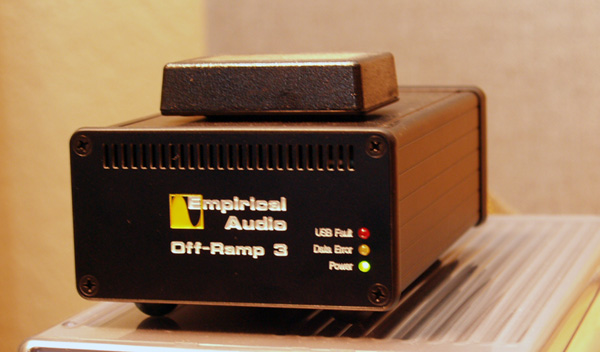
Say you need a way to get USB out of a PC and into a DAC that is not USB, or you just want to re-clock the signal to like... well, say almost to nil, then go for the new Empirical Audio Off-Ramp 3. I have one here with the Superclock 4 ($999 as configured) and since it allows for 24/96 files... yikes, this the cat's pajamas! It works better than the earlier version, and looks better too! Of course I am running on distant memory here, but if I recollect correctly how the older one sounded, the new Off-Ramp is silkier, richer, and more at ease with the music in a way more natural way... and you get resolution to 11 with no hint of grain, grit, and crap. Nice and sweet. Actually, sweet is the best descriptor I can think of... music through the newest version has such a lovable sweetness to it that it is rather addicting. It makes all my digital files sound simply wonderful.
No glitches and easy plug-and-play with my Mac Book... the Off-Ramp 3 simply works. The Off-Ramp 3 offers captive outputs for either S/PDIF coax or AES/EBU XLR. It also has an I2S output and sounds quite fine via the 12V wall-wart supply. I did try it with my Empirical battery supply (used with the Pace Car I have here) and found little to suggest the need for that unit's extra expense. Of course I am using the wall-wart via the Audio Magic Transcendence AC unit, so perhaps that is why, but who cares? The Off-Ramp 3 is killer and since it does 24/96 and sounds so damn nice... and that I find that it is very competitive sonically with the older Pace Car (the version I have here does not do 24/96), well... I am not using the Pace Car much at all. The Pace Car also uses the Superclock 4 and well... darn if I hear much to say that it is better than the latest Off-Ramp 3. Besides the Off-Ramp is for me a more practical alternative to the Pace Car (being USB and 24/96), has that captive XLR output (the Pace Car has a pig-like-tail to connect to), and well... I like what the Off-Ramp 3 does to my music.
With it in the chain, I hear more ambient information, more air, and more of that subtle subtle stuff... you get more information in way that is more involving, but with no stress, hype, or any of that overly-analytical crap that calls attention to itself, "Listen to me, I am resolution!" "I am etched exaggerated detail up the caboose!" What you get with the Off-Ramp 3 is the desire to want to pay attention... the music becomes quite sublime and alluring. You get it all in way that is more there there. More real and sweet. Not euphonic, nor is it over-the-top sugary-coated molassesy syrup, you just get more of that ...rightness. It really makes the bits less digital and more analog-ish-like. But then again, yeah, it ain't analog, but it sure sounds like it!
With it out of the chain, I hear less. Less of what I want and less of what I like. And I listen less.
Way recommended.
Empirical Audio www.empiricalaudio.com
Audioengine W2 and W1
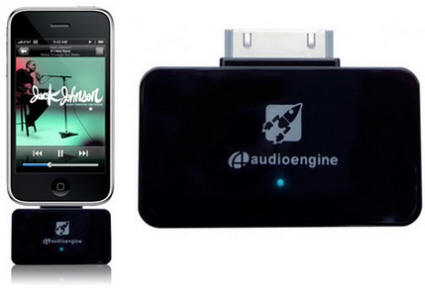
Which then takes me to the… ah yes the Audioengine W2 ($169 wireless adapter for iPod) and W1 ($149 wireless audio adapter for your computer). Both of these devices work pretty much the same, but are intended to be used with differing devices. Work they do my man… simple, easy, and plug and play… all without a hitch. We have been using the W2 (shown above) with our latest generation iPod to send music to the Virtue Audio Two integrated system in the kitchen where Carol finds herself not only cooking food, but where the music is cooking too. The W2 sounds quite nice and does what one wants: to get the music off an iPod and into the room as easily as is possible and do so with as little sonic degradation as is possible. It does require the iPod to supply the power, so the fact that the iPod's battery is now serving two purposes, the music won't last quite as long, but then again, not so sure that is an issue based on how one is going to use this device. Party time!
CD quality? Well… I would say that what music you have on your iPod will sound at least as good if not better than what you are used to via headphones (it all depends on the system one is feeding versus the headphones one uses). What you got is what you get. The better the file format (Mp3, AIFF, Apple Lossless, etc.) will also make a difference—garbage in, garbage out.
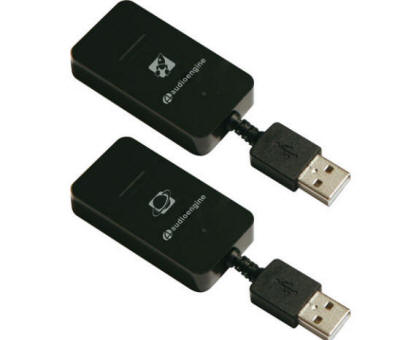
Same applies to the W1 (shown above)… easy to use and what I have on my PC can easily be sent to any system within shouting range. Great for a party where one wants to play their music files (iTunes, etc.) to another system (say one out on the patio)… works great and sounds rather fine too. Is this better than using an external DAC… again, is it CD quality? Depends. No, not when compared against my reference sources spinning CDs (the EMM CDSA/SE, Playback Designs MPS-5, and the Cary CD-306 Professional players, all which cost $10k and up, and so duh) or when used as external DACs, but certainly when compared against any decent mid-priced CD player spinning CDs or that of an affordable external DAC (say in the sub $500 range) that I am familiar with (the W1 is a true 16/44.1 performer... mighty nice in such a little box!). Reminds me of the Devilsound DAC sonically... quite nice. But like I said above regarding the W2, the better the file format (Mp3, AIFF, Apple Lossless, FLAC, etc.) will make a difference—garbage in, garbage out.
See, the W1 is all about 'sharing' the music, being more casual and in the background—getting it from point A to point B… it is more about having your music available where you want it… than say being some high-end state-of-the-art musical device where one is going to do any critical listening. It works and used as it is intended, you won't notice any differences sonically as you'll be too busy enjoying the music in whatever setting you are in at the moment. The W1 and W2 are both highly recommended for those who need to get their music out and around with no fuss or problems.
Audioengine www.audioengineusa.com
Artisan Silver Dream interconnects
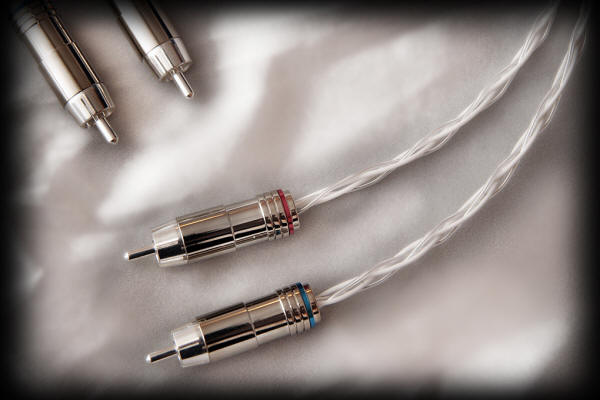
Now before I end this Ramblings, I want to mention again a wonderful 'analog' interconnect I have been using here with various projects: the Artisan Silver Dream cables. I briefly mentioned this stellar product in a prior Ramblings and well… I just can't get over how wonderful these cables are. They have none of the dreaded 'silver' glare and yet possess all the harmonic 'rightness' silver can bring to the table. These are simply amazingly good for so little cash. They make music and do so with little to complain about. Yeah, they give up a bit in the resolution camp, and sure they are more dark than light (say warmer than cooler and richer than leaner… but I can live with either of those in a heartbeat), but they get the essence of the music across and do so without drawing any attention to themselves… what more can I say? (£189 a meter from )
Artisan Cables www.artisansilvercables.com
